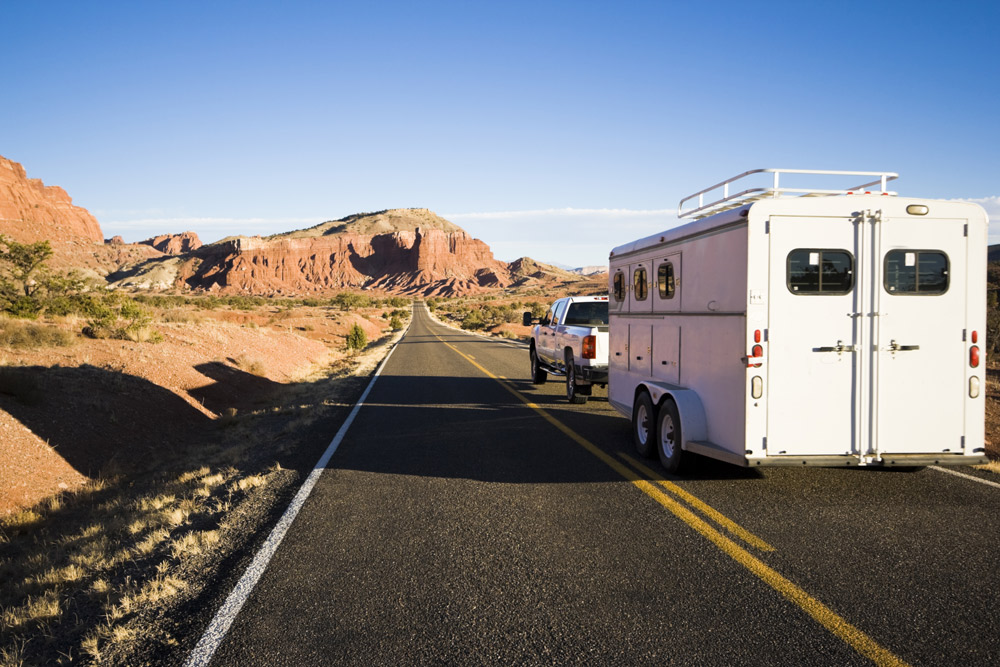What if you had to pull your rig off the highway to handle a roadside emergency? Here’s what to do and how to stay safe.
Traveling with horses can be a bit nerve-wracking at times, particularly if you find yourself in a situation where you need to make a sudden unplanned stop. This step-by-step procedure will help keep you and your horses safe in case you need to take care of a roadside emergency.
Step1. Pull Over Safely
If you’re on a major highway, freeway, expressway or multilane road, knowing how to safely stop your rig can mean the difference between life or death.
Ease onto the right shoulder. If you feel there’s something wrong with your truck or trailer, slow down, turn on your right turn signal and emergency flashers, and ease into the far right lane. From there, you should be able to safely pull off the highway and onto the right shoulder if available. Look for a wide spot, and keep your emergency flashers on.
Stay off the median. Never pull into the center divider area of the road, regardless of how wide and stable it may look.
Get off the freeway. If you think you can drive a short distance, try to get completely off the freeway.
Consider the off ramp. Some off ramps feature a large grassy area that can be used as an emergency parking spot. Watch for sprinkler heads, and pull off the road as far as is safely possible.
Look for off-street parking. If there’s no shoulder, or you can’t tell if the shoulder’s terrain will support your rig – and you can keep moving – look for another stopping place, such as a shopping center parking lot, an open fi eld, or a gas station.
Leave your horse inside. Never unload your horse from the trailer on a busy highway (unless absolutely critical) – it’s just too risky. If the horses are down, leave them. Although that sounds harsh, whatever injuries they have suffered probably won’t worsen – but they will if they get hit by a passing motorist.
Turn off the engine. Once stopped, turn off the engine. Relax, and take a few deep breaths; if you’re calm, you’ll deal better with the emergency.
Step out carefully. Before you get out of your vehicle, check your rearview mirrors for oncoming traffic. As you step out, stay as close as possible to the side of your rig. Check your vehicle on both sides to determine the problem.
Light flares. Estimate how far off the pavement edge you’re parked. Most states require you to set flares if you’re within five feet of the pavement’s edge. However, for visibility, it’s best to set flares any time you’re forced to pull onto the shoulder of the road (you can use reflector triangles in a pinch). Ideally, place four flares behind your trailer and two in front of your tow vehicle.
Calm your horse. Talk to your horses through the trailer windows. Keep your voice calm and reassuring. And don’t open trailer doors – excess noise can cause the horses to panic, and opening the doors may make them think you’re unloading.
Step 2. Fix the Problem or Call for Service
If you know what you’re doing and are completely off the road, you can get out your emergency kit and fix the problem. Otherwise, call for emergency roadside service. When considering membership in an emergency roadside service plan, query your local agent about the following considerations. Know that not all companies will work with your trailer and/or horses – so ask these questions ahead of time.
• Size restrictions. Is there a restriction on tow vehicle size/weight to qualify for coverage?
• Towing services. If towing is required, what distance will the plan cover and how will the bill be paid? Will the trailer also be towed? Is there a restriction on trailer size/weight? May the trailer be loaded with horses?
• Fuel/water. Will the service supply fuel (gasoline/diesel) and water?
• Lockouts. Will the service open your tow vehicle and/or trailer in case you get locked out?
• Flat tires. Will the service change a dually flat? Tires with split rims? Are there any tire size restrictions? Will the service cover trailer flats?
• Availability. Is the service available 24/7, including holidays? Is it available everywhere, such as out of state, across the nation, on United State Forest Service roads?
• Cost. What’s the cost difference between service levels? (You might need to choose, for instance, among “basic”, “expanded” and “deluxe” service plans.) Is there a toll-free emergency roadside service number?
Step 3. Get Back on the Road
Once you’ve taken care of the problem, or have called for assistance, your next challenge will be to get back into traffic flow. Don’t expect anyone to stop for you – you’ll need to achieve highway speed. Here’s how:
Turn on lights. Turn on your left turn signal and emergency flashers.
Ease forward. Turn on your engine, and ease forward. Build speed. Start building speed on the shoulder of the road.
Check your mirrors. Keep looking into rearview mirrors on both sides. As you do, check the shoulder ahead to make sure you’re safe.
Merge. When you see a break in the traffic – or you see someone slow down or move over for you (watch for the flashing headlights signal) – move into the flow of traffic, then turn off your left turn signal. Once you’ve reached the speed limit, turn off your emergency flashers.
Recognize courtesy. If someone lets you in, flash your headlights to thank them.
Maintenance for Prevention
As a responsible horse owner, being prepared and keeping your vehicle maintained are the best ways to reduce the chances of a roadside emergency. Here is a pre-trip checklist to assist you in making sure you’re prepared for you next trip:
• Check the tow vehicle. Check and replenish engine fluid levels and wiper fluid. Towing puts extra stress on the radiator, brakes and transmission. Make sure fl uid levels are correct.
• Make sure the ball on the tow vehicle is the correct size for the horse trailer.
• Make sure the rearview mirrors are properly adjusted and you know how to use them.
• Check tire pressure on the tow vehicle and trailer. Improper tire pressure is responsible for most towing problems. Check tire condition and be aware that due to minimal use, trailer tires may age out before they wear out.
• Make sure the horse trailer is level so the animals are not always fighting their balance by traveling uphill or downhill. This movement can cause the trailer to sway and cause other safety problems.
• Check lug nuts on wheels. Wheel nuts and bolts should be torqued before first road use after each wheel removal. Check and re-torque after the first ten miles, 25 miles, and again at 50 miles. Check periodically thereafter.
• Check inside the horse trailer for bee and wasp nests.
• Check over your hitch, coupler, breakaway brake battery and safety chains. Make sure the brakes and all lights are working properly before you load the horses.
• When horses are loaded, make sure all doors are latched properly and horses are tied.
• Drive down the driveway, and before you turn onto the main road, get out and check everything again. Something you overlooked may make itself apparent by then. Most accidents happen to people who have been hauling just long enough to get lackadaisical.
• If you happen to stop somewhere where the rig has been left unattended, check everything all over again. Someone may have been tampering with the trailer or horses.
An unexpected roadside emergency can happen to anyone at any time. Keeping your truck and trailer in good condition, and being well prepared, are key to ensuring you and your horses get back on the road smoothly and safely. Happy hauling!
Usrider provides roadside assistance and towing services along with other travel-related benefits to its members through the equestrian motor plan. It includes standard features such as flat-tire repair, battery assistance and lockout services, towing up to 100 miles plus roadside repairs for tow vehicles and trailers with horses, emergency stabling, veterinary referrals and more. For more information about the Usrider Equestrian Motor Plan, visit usrider.org or call (800) 844-1409.








